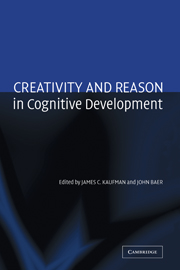Book contents
- Frontmatter
- Contents
- List of Contributors
- Acknowledgments
- Creativity and Reason in Cognitive Development
- Introduction
- COGNITIVE PERSPECTIVES
- 1 Expertise and Reason in Creative Thinking: Evidence from Case Studies and the Laboratory
- 2 Creative Genius, Knowledge, and Reason: The Lives and Works of Eminent Creators
- 3 Dynamic Processes Within Associative Memory Stores: Piecing Together the Neural Basis of Creative Cognition
- 4 The Creativity of Everyday Moral Reasoning: Empathy, Disgust, and Moral Persuasion
- 5 Reasoning and Personal Creativity
- 6 Alternative Knowledge Structures in Creative Thought: Schema, Associations, and Cases
- 7 The Role of the Knowledge Base in Creative Thinking
- 8 The Role of Domain Knowledge in Creative Problem Solving
- 9 Creative Thinking and Reasoning: Can You Have One Without the Other?
- 10 From Alexithymia, Borne of Trauma and Oppression, to Symbolic Elaboration, the Creative Expression of Emotions, and Rationality
- 11 Opening up Creativity: The Lenses of Axis and Focus
- DEVELOPMENTAL AND EDUCATIONAL PERSPECTIVES
- Author Index
- Subject Index
- References
10 - From Alexithymia, Borne of Trauma and Oppression, to Symbolic Elaboration, the Creative Expression of Emotions, and Rationality
Published online by Cambridge University Press: 19 January 2010
- Frontmatter
- Contents
- List of Contributors
- Acknowledgments
- Creativity and Reason in Cognitive Development
- Introduction
- COGNITIVE PERSPECTIVES
- 1 Expertise and Reason in Creative Thinking: Evidence from Case Studies and the Laboratory
- 2 Creative Genius, Knowledge, and Reason: The Lives and Works of Eminent Creators
- 3 Dynamic Processes Within Associative Memory Stores: Piecing Together the Neural Basis of Creative Cognition
- 4 The Creativity of Everyday Moral Reasoning: Empathy, Disgust, and Moral Persuasion
- 5 Reasoning and Personal Creativity
- 6 Alternative Knowledge Structures in Creative Thought: Schema, Associations, and Cases
- 7 The Role of the Knowledge Base in Creative Thinking
- 8 The Role of Domain Knowledge in Creative Problem Solving
- 9 Creative Thinking and Reasoning: Can You Have One Without the Other?
- 10 From Alexithymia, Borne of Trauma and Oppression, to Symbolic Elaboration, the Creative Expression of Emotions, and Rationality
- 11 Opening up Creativity: The Lenses of Axis and Focus
- DEVELOPMENTAL AND EDUCATIONAL PERSPECTIVES
- Author Index
- Subject Index
- References
Summary
Alexithymia is a term introduced by Sifneos (1973) to refer to individuals who have difficulty in verbalizing symbols, lack an ability to talk about feelings, have an impoverished fantasy life and drab dreams, have difficulty describing and pointing to pain in their own bodies, tend to express psychological distress by focusing on external concerns and their somatic symptoms rather than on emotions, show an overconformity in their interpersonal relationships, have a reduced ability to experience positive emotions together with a susceptibility to poorly differentiate negative affects, and lack a productive, creative involvement with the world. This psychiatric syndrome was described by Sifneos (1973), who observed an impoverished fantasy life among psychosomatic patients, who, in comparison to psychoneurotic controls, showed a utilitarian way of thinking that considers other people to be objects to be manipulated (Marty & de M'Uzan, 1963).
There is evidence that highly humiliating experiences and experiences that are deeply and massively traumatic, such as being physically and verbally abused as a child, being a victim of repeated sexual assault (Zeitlin, McNally, & Cassiday, 1993), experiencing high levels of the affective, unpleasantness component of pain (Lumley, Smith, & Longo, 2002), having pain induced in an experimental setting (Kaplan & Wogan, 1977), having been imprisoned in a Nazi concentration camp (Krystal, 1968), experiencing traumatic events in the social environment (Krystal, 1988, van der Kolk, 1987), having a catastrophic and painful illness (Fukunishi, Tsuruta, Hirabayshi, & Asukai, 2001), suffering from posttraumatic stress disorder (PTSD; Zeitlin, Lane, O'Leary, & Schrift, 1989; Henry, Cummings, Nelson, & McGhee, 1992; Söndergaard & Theorell, 2004), being a heroin addict in the drug-withdrawal state (Krystal, 1962), having an antisocial personality disorder as a result of pathological socialization.
Information
- Type
- Chapter
- Information
- Creativity and Reason in Cognitive Development , pp. 177 - 201Publisher: Cambridge University PressPrint publication year: 2006
References
Accessibility standard: Unknown
Why this information is here
This section outlines the accessibility features of this content - including support for screen readers, full keyboard navigation and high-contrast display options. This may not be relevant for you.Accessibility Information
- 1
- Cited by
